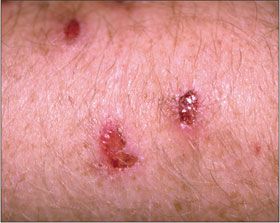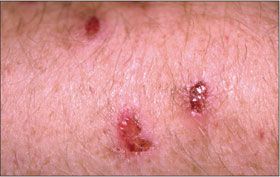Case 3: Pruritic, tender lesions persist after antibiotics and corticosteroids-what next?
For 6 months, a 54-year-old woman has had a chronically pruritic and tender eruption that is confined to her arms. She has been treated with ciprofloxacin, clarithromycin, mupirocin, and topical corticosteroids. About 2 years earlier, she underwent spinal fusion. She takes unknown pain medications, omeprazole, buspirone, propranolol, and estrogen.
Case 3:

For 6 months, a 54-year-old woman has had a chronically pruritic and tender eruption that is confined to her arms. She has been treated with ciprofloxacin, clarithromycin, mupirocin, and topical corticosteroids. About 2 years earlier, she underwent spinal fusion. She takes unknown pain medications, omeprazole, buspirone, propranolol, and estrogen.
What is your clinical impression?
A. Methicillin-resistant Staphylococcus aureus infection.B. Candidiasis.C. Psoriasis.D. Photoallergic drug reaction.E. Lichen simplex chronicus.
(Answer on next page.)

The patient had no primary lesions and had not responded to antibiotics; none of her medications were photosensitizing. These features suggested the diagnosis of lichen simplex chronicus, E, or factitial dermatitis. This anxious patient with chronic pain would pick at her forearms, producing the resultant lesions. Cultures were negative, although such lesions are prone to secondary infection. Occlusive dressings are a temporary treatment until the underlying compulsive behavior is addressed.
Man with lichen simplex chronicus
Lichen simplex chronicus associated with hepatitis C